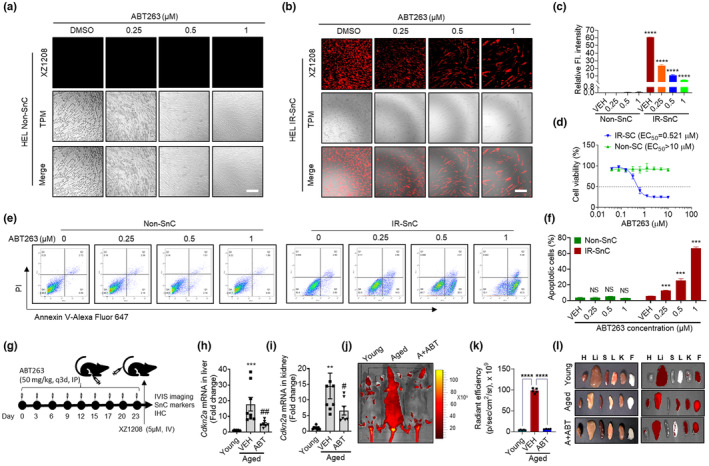FIGURE 4.

Detection of senolytic effects of ABT263 by XZ1208 in vitro and in vivo. (a, b) HEL non‐SnCs and IR‐SnCs were treated with indicated concentrations of ABT263 for 72 h, incubated with 10 μM XZ1208 for 48 h, and imaged via confocal microscopy. Scale bar, 200 μm. (c) Quantification of fluorescence intensity for (a, b). Data are mean ± SEM (n = 3 independent assays). (d) HEL non‐SnCs and IR‐SnCs were treated with indicated concentrations of ABT263, with viability determined by MTS assay at 72 h after ABT263 treatment. EC50, half‐maximal effective concentration. Data are mean ± SEM (n = 3 independent experiments). (e) ABT263 induced apoptosis selectively in HEL IR‐SnCs in a dose‐dependent manner. HEL non‐SnCs and IR‐SnCs were treated with indicated concentrations of ABT263 for 72 h. Representative flow cytometry analysis of apoptosis is shown. PI, propidium iodide. (f) Quantification of apoptotic cells in (e). Data are mean ± SEM (n = 3 independent assays). (g) Illustration of experimental design. Mice aged 20 months (aged) were given 50 mg/kg ABT263 via intraperitoneal injection every 3 days (q3d) for a total of nine injections, mice were injected with 5 μM XZ1208 intravenously via the tail vein and imaged after 24 h. After imaging, mice were euthanized to harvest various tissues for analysis. (h, i) Expression of Cdkn2 in liver (h) and kidney (i) was measured by qRT‐PCR (n = 8 mice for young and aged groups, n = 7 mice for ABT263‐treated group). (j–l) Mice and major organs/tissues were imaged at 24 h after injection with 5 μM XZ1208 (five mice from (g) were randomly selected for XZ1208 injection and imaging). H = heart, Li = liver, S = spleen, L = lung, K = kidney, F = fat. Data are mean ± SEM. Data were analyzed by one‐way ANOVA with Tukey's post hoc tests. *p < 0.05, **p < 0.01, ***p < 0.001, and ****p < 0.0001 compared to vehicle (VEH) in d and f; # p < 0.05, ## p < 0.01, ### p < 0.001, and #### p < 0.0001 compared to VEH group in H, I, and K. NS, not significant.
